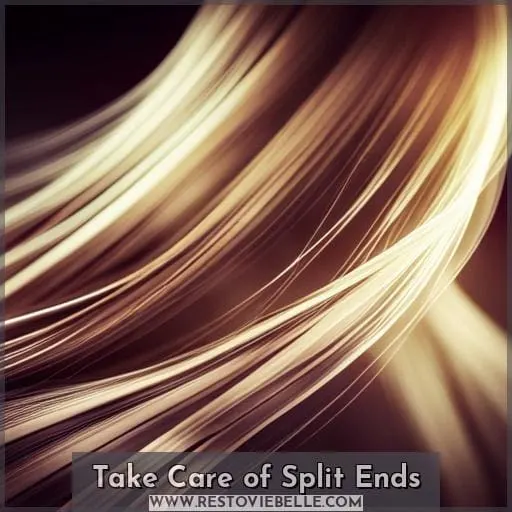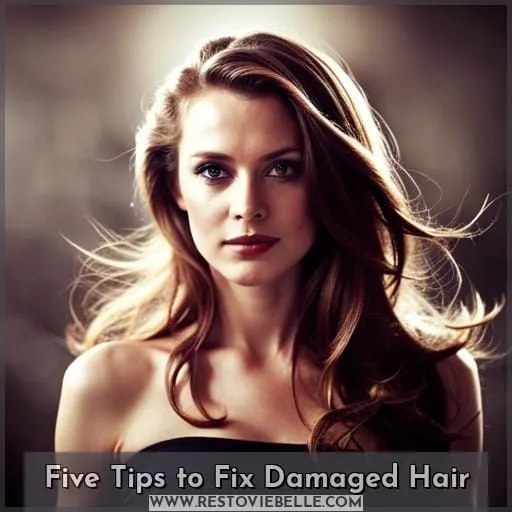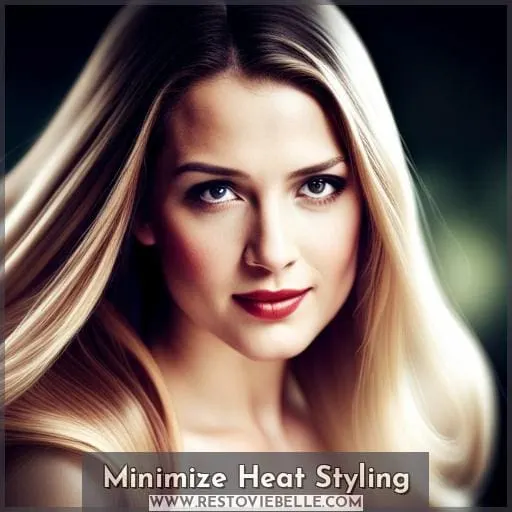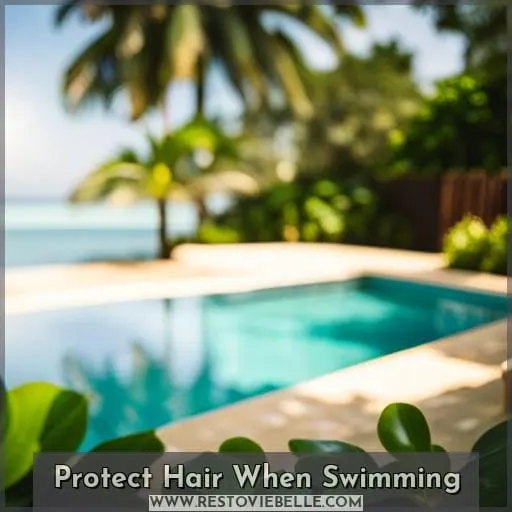This site is supported by our readers. We may earn a commission, at no cost to you, if you purchase through links.
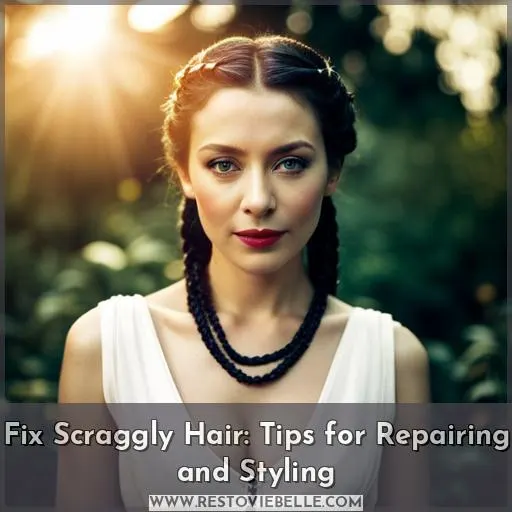 A tangled mop of scraggly hair can be a major confidence-killer. But fear not, you don’t have to suffer in silence! Taking the time to understand how to fix your scraggly hair is an empowering step towards finding hairstyles that better suit your look.
A tangled mop of scraggly hair can be a major confidence-killer. But fear not, you don’t have to suffer in silence! Taking the time to understand how to fix your scraggly hair is an empowering step towards finding hairstyles that better suit your look.
Like a phoenix rising from the ashes, let’s explore some tips and tricks on how you can transform those split ends into sleek locks worthy of any red carpet event.
To start off with a bang – literally – avoid heat styling whenever possible as this amplifies damage and breakage that leads to stringy strands. Instead, opt for regular conditioning treatments coupled with scalp conditioning treatments which will help restore moisture levels without damaging delicate follicles further down the line.
Table Of Contents
Key Takeaways
- Avoid excessive heat styling.
- Use lukewarm water for washing.
- Regularly condition with hydrating products.
- Get regular trims to prevent further damage.
Take Care of Split Ends
To take care of split ends, it is essential to maintain a proper hair-washing routine, treat any scalp conditions with specialized products and treatments, minimize heat styling as much as possible, and condition your hair regularly.
Developing good habits like these will help create healthier-looking tresses that are less prone to splitting or fraying at the ends.
Proper Hair Washing Routine
You can reduce excess oil and product buildup, control split ends, and maintain healthy hair with a balanced hair-washing routine.
- Pick the right shampoo for your scalp type – oily or dry/normal – to avoid overstripping moisture from your locks.
- Select lukewarm water temperature; hot water will strip away essential oils that protect the cuticle layer of your strands, reducing their sheen and strength.
- Finish off with an intense moisturizing conditioner while avoiding the root area to keep it light. This will prevent greasiness but also nourish the ends properly for improved texture and appearance, fixing scraggly hair.
Scalp Condition Treatment
Tame your scraggly hair like a lion tamer with specialized scalp condition treatments that can help reduce split ends. Consider consulting a dermatologist for customized hair and scalp therapy to identify the root cause of split ends and determine the best remedy.
A balanced diet, regular trims, and deep conditioning sessions are key steps in improving your hair’s appearance.
To protect your hair from outdoor elements, make sure to use sunscreen. If you enjoy swimming, wearing a swimming cap can prevent chlorine damage when taking dips in pools or lakes.
Lastly, consider using ammonia-free color care shampoo to preserve both moisture and color without damaging delicate strands.
Minimizing Heat Styling
Opt for heatless styling alternatives when dealing with split ends to help minimize damage. Use heat protectants when using tools, but try to avoid them as much as possible. Hair sunscreen is also important in reducing sun-related damage and fading of color-treated hair.
Focus on styling techniques that don’t require high heats. For example, air drying or braiding wet hair before sleeping. After shampooing your split ends, use a lightweight oil and lightly brush through with a wide-tooth comb while it’s still damp for gentle repair work without causing further breakage.
Treat damaged hair carefully by avoiding harsh chemicals and regularly using deep conditioners.
Regular Conditioning
Regularly using hydrating conditioners can keep split ends at bay and make your hair more manageable. Deep conditioning, hair masks, leave-in treatments, and moisturizing oils are some of the best options to prevent scraggly hair.
Be Patient With Repairing Scraggly Ends
It can take time and patience to repair scraggly ends, but the effort will be worth it. Think of it like tending a garden: you need to water your plants regularly and give them the nourishment they need for strong roots.
Hair nurturing is key when dealing with split ends. Use lightweight products or oil on wavy hair.
Regular trims help prevent further damage while semi-permanent colors help keep color in check. Heat protectants are essential, as well as protecting strands from outdoor elements like pool chlorine or sun exposure.
Deep conditioning treatments also assist in reviving damaged locks by replenishing lost moisture levels, which helps promote end recovery over time.
Whatever you do, make sure that whatever regimen you decide works best gives your locks lots of love–it’ll definitely show once all is said and done.
Five Tips to Fix Damaged Hair
If you’re dealing with damaged hair, try these five tips to help restore it.
Hair masks are a great way to deeply condition and hydrate your strands while repairing split ends. Try the SheaMoisture Jamaican Black Castor Oil Conditioner or OGX Extra Strength Argan Oil Hair Mask for added nourishment and shine.
For additional protection against UV rays and everyday damage, use an organic sunscreen spray like Soleil Shield Organic Hair Sunscreen Spray before styling.
Split ends can also be treated with regular trims at the salon or by using gentle heat tools on lower settings when styling at home – just make sure to apply a heat protectant!
Last but not least, check out specialized shampoos like ADV Argan Range that address specific issues such as scalp dryness and excess oil buildup which can both contribute toward scraggly hair.
With consistent care, you’ll soon see healthy results!
Early Detection of Damage
It’s important to be proactive when it comes to fixing scraggly hair. Early detection of damage is key in order to prevent further harm from occurring and taking the necessary steps for repair.
Regular assessments of your hair can help identify potential issues early on that could lead to breakage or split ends, such as over-coloring or using too many styling products. A regular evaluation will also allow you to measure how well protective measures like sunscreens are working for you.
Additionally, focusing on nourishing ingredients and treatments specifically tailored towards improving damaged strands can make a big difference in restoring health back into the hair shafts. Keeping track of these changes with a regular assessment ensures that any underlying problems are addressed before they become more serious.
Visit a Hairdresser for a Trim
Visit a hairdresser for regular trims to ensure your hair stays smooth and healthy – they’ll give you an almost heavenly experience! Getting professional advice from a stylist can help keep split ends at bay, leaving your hair looking silky and soft.
Hairdresser consultations are essential for fine haircare as they’ll recommend the best cut and styling tips that suit you. A good haircut is tailored specifically to every individual’s scalp condition, lifestyle, and texture of their mane.
Regular trims also protect against damage caused by hot styling tools, which weaken strands over time, leading to breakage or stringy locks. Professional hairstylists have all the necessary knowledge when it comes to creating looks that flatter while keeping moisture in check, without compromising on style or length.
So if you want your tresses full of life, there’s no better place than visiting a hairdresser right away!
Minimize Heat Styling
Now that you’ve visited your hairdresser for a trim, it’s time to look at styling options and reduce the amount of heat you use on your hair. Heat can cause further damage and prevent any progress made from the visit to the salon.
Try out some of these tips to minimize heat styling:
- Look into using heatless alternatives such as silk scarves or protective hairstyles like braids.
- Invest in cold-styling methods such as air drying with a diffuser for curly hair types.
- If possible, go longer between washes so that there is less need for blowdrying when wet.
By following these steps consistently over time, scraggly strands should gradually be replaced by strong, healthy ones due to increased protection against environmental factors combined with gentle treatment practices designed especially for fragile locks!
Temporary Cessation of Chemical Treatments
To avoid further damage to your hair, consider taking a break from chemical treatments like coloring and bleaching for a while. Chemical treatments can cause drastic changes in the health of your hair and scalp, leading to dryness, split ends, or even more severe issues such as scalp irritation or balding patches.
To protect your locks during this time off from chemicals, use clarifying shampoo on occasion to remove any excess oil buildup. Opt for sunscreen protection when exposed outdoors and cover up with scarves or hats when necessary.
Rinse out chlorine after swimming in pools and never sleep on wet hair without drying it thoroughly first.
In addition to these measures, you should maintain healthy habits overall. Eating nutrient-rich food helps nourish strong tresses, while avoiding heat styling tools keeps them safe too! Commitment is key, though.
Protect Hair When Swimming
Protect your hair while swimming with a swim cap to keep it safe from chlorine and other chemicals. A swim cap can be beneficial for many reasons, such as providing UV protection and helping to minimize heat damage from the sun.
Plus, they help reduce the amount of harsh chlorine that comes in contact with your curls or waves – which is essential when fixing scraggly hair!
If you plan on taking a dip in saltwater, make sure you rinse off after swimming to remove any buildup caused by minerals like calcium chloride and magnesium sulfate found in saltwater pools.
Additionally, maintaining an overall healthy routine including regular trims (to prevent split ends), using conditioners designed for curly or wavy hair types after each wash session; plus avoiding brushing wet strands – are all important steps when looking out for how best to protect your precious locks while underwater!
Conclusion
Beauty isn’t just skin deep; your hair reflects your health. If you have scraggly hair, it could be a sign of neglect or damage. To fix it, pay attention to the products and treatments you use, as well as the amount of heat styling and chemical treatments you do.
Repair split ends with a balanced hair-washing routine, scalp condition treatment, and regular conditioning. Be patient with repairing scraggly ends and minimize heat styling. Here are five tips to fix damaged hair: maintain a nutrient-rich diet, detect damage early, get a trim from a hairdresser, minimize heat styling, and temporarily stop chemical treatments.
Protect your hair when swimming and use specialized products like hair sunscreen to keep it healthy and hydrated. Fixing scraggly hair takes time, but with dedication and the right products, you can transform your tresses.
